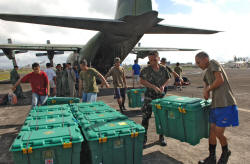Rotary to the Rescue
By Frank Deaver
Rotary Club of Tuscaloosa, Alabama USA
The debate goes on. Is global warming the result of human activity,
or is it only an earthly cycle repeated naturally at long intervals?
In either case, the natural disasters of recent years clearly seem
to have been more frequent and more devastating than in earlier
times. Governments and social agencies have been increasingly more
responsive with aid, thanks in large part to better communication
and more rapid transportation.
 But
let us not overlook the benefit of innovation, often in the form of
a "simple idea" put into action. Such was the introduction in 2000
of the Rotary ShelterBox, conceived in the mind of Rotarian Tom
Henderson of the Helston-Lizard Rotary Club in Cornwall, England. As
he describes it, "It's a simple package of aid delivered to the most
needy people in the shortest amount of time." Its success merited a
recent CNN broadcast, praising its humanitarian service. See
website: But
let us not overlook the benefit of innovation, often in the form of
a "simple idea" put into action. Such was the introduction in 2000
of the Rotary ShelterBox, conceived in the mind of Rotarian Tom
Henderson of the Helston-Lizard Rotary Club in Cornwall, England. As
he describes it, "It's a simple package of aid delivered to the most
needy people in the shortest amount of time." Its success merited a
recent CNN broadcast, praising its humanitarian service. See
website:
www.cnn-7.vo.llnwd.net/e7/cnn/services/podcasting/cnnheroes/video/2008/09/09/heroes.tom.henderson.cnn.m4v
  The
ShelterBox is "small enough so two people can carry it," Tom
explains, but "large enough to get equipment in for ten people."
Designed to help an extended family survive for a minimum of six
months, the lightweight, weatherproof box contains items such as a
10-person tent, blankets, basic tools, water-purification tablets, a
compact stove, mosquito nets, and other items tailored to the
particular region in crisis. The
ShelterBox is "small enough so two people can carry it," Tom
explains, but "large enough to get equipment in for ten people."
Designed to help an extended family survive for a minimum of six
months, the lightweight, weatherproof box contains items such as a
10-person tent, blankets, basic tools, water-purification tablets, a
compact stove, mosquito nets, and other items tailored to the
particular region in crisis.
Although ShelterBox originated in England and its operation was at
first only from there, it has become a worldwide network with
distribution hubs in many countries. "This allows ShelterBox to
respond within 72 hours of a disaster anywhere in the world," Tom
says proudly. ShelterBox is nonpolitical, accepting no funding from
government agencies. Donations from Rotary Clubs worldwide help fund
the boxes, each of which costs approximately $1000 USD. "Nobody can
buy our boxes," Tom says. "They are only available for free."
In January 2001, the first 143 ShelterBoxes were flown to
earthquake-ravaged Gujarat, India. As of 2006, the ShelterBox
organization had responded to more than 70 disasters in 46
countries, aiding more than a half-million victims.
As this is written (September 2008), ShelterBoxes are being
distributed in Nepal, where severe flooding displaced as many as
70,000 people. Last month (August) 200 ShelterBoxes were sent to the
Ukraine, where floods and landslides forced up to thousands of
people from their homes. And in the devastating Myanmar cyclone,
2000 ShelterBoxes were delivered to the hardest hit areas of the
Irrawaddy Delta.
Yes, ShelterBox was a "simple idea," conceived in the mind of one
Rotarian, launched by one Rotary Club, and that grassroots Rotary
project has rapidly grown to an international level. The
international relief agency Feed the Children has called Tom's
ShelterBox the best disaster relief tool they have seen in their 20
years of experience.
So what other "simple ideas" lie dormant in the minds of Rotarians
around the world? Surely there are more "simple ideas" that can also
grow into community-wide, or world-wide, programs of Rotary Service.
Also see more about ShelterBoxes at
www.rghf.org/drrag
|

 But
let us not overlook the benefit of innovation, often in the form of
a "simple idea" put into action. Such was the introduction in 2000
of the Rotary ShelterBox, conceived in the mind of Rotarian Tom
Henderson of the Helston-Lizard Rotary Club in Cornwall, England. As
he describes it, "It's a simple package of aid delivered to the most
needy people in the shortest amount of time." Its success merited a
recent CNN broadcast, praising its humanitarian service. See
website:
But
let us not overlook the benefit of innovation, often in the form of
a "simple idea" put into action. Such was the introduction in 2000
of the Rotary ShelterBox, conceived in the mind of Rotarian Tom
Henderson of the Helston-Lizard Rotary Club in Cornwall, England. As
he describes it, "It's a simple package of aid delivered to the most
needy people in the shortest amount of time." Its success merited a
recent CNN broadcast, praising its humanitarian service. See
website: